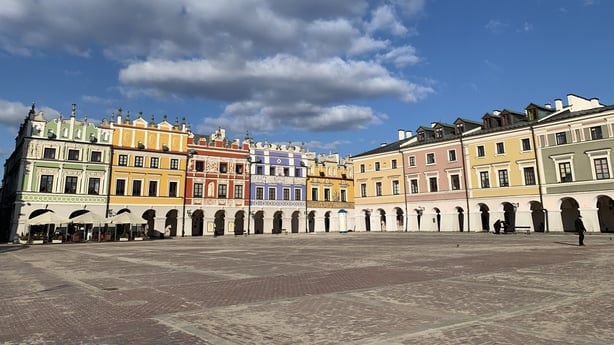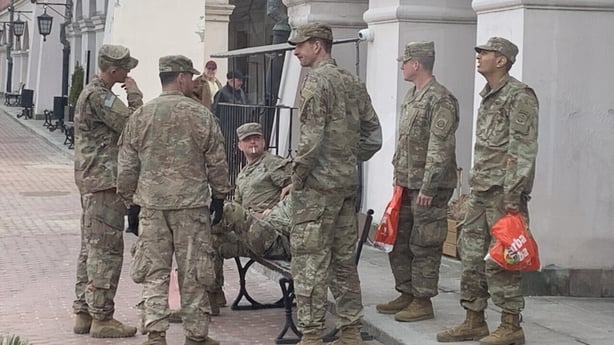Latest update from 1pm
I'm here at what is known as the Rotunda memorial in Zamosc, Poland. It is located just 60km from the border with Ukraine.
It is the site where over the course of World War II, the Gestapo shot an estimated 8,000 people, all those people were from this local area.
The Gestapo shot them here and they burned their bodies here. This illustrated very starkly the fact that this area is no stranger to war and the terror that comes with war.
Today I wanted to explore how people here feel about the fact that war is yet again at their doorstep. Among the people I have been speaking to is Magdalena who is a local tour guide.
When I asked her if people here were afraid she said: "They are uneasy. Some of us, for sure because we don't know the future. It's unpredictable. We hope it will not but we can not be sure it will not.
"It's like a tension that you feel all the time."
Magdelana told me that routine and keeping busy is what's keeping people going. A huge part of keeping busy these days is getting involved with the tremendous refugee effort here locally.
It seems that almost everybody is involved in that operation. It is very necessary because we have more evidence today that those refugees are continuing to come and the numbers are growing.
Almost 3 million people in total have fled Ukraine and 1.8 million of those have come here to Poland.
We need your consent to load this rte-player contentWe use rte-player to manage extra content that can set cookies on your device and collect data about your activity. Please review their details and accept them to load the content.Manage Preferences
Latest update from 11am
On our very first day in Zamosc myself and cameraman Paul Deighan stumbled upon its Rotunda monument.
It is on the outskirts of the town, and it is where the Gestapo massacred an estimated 8,000 people during World War II.
A large white cross commemorates those who were slaughtered. The monument is surrounded by hundreds of graves, of soldiers and others killed in the war.

Zamosc is no stranger to terror and destruction. It's very architecture bears testimony to that. Extensive old ramparts and fortifications surround its 16th century renaissance core, built by workers brought from Italy.
In the centuries since then, the town has endured siege, invasion, occupation, bombing, and slaughter.
A second monument in the town centre remembers the thousands of children torn from their families during the second world war and either sent to the camps to be killed or transported on trains to Germany to be "aryanised".
All this is within living memory of its oldest inhabitants, and so it is no wonder that empathy for the Ukrainian women and children pouring through the town in their thousands is so strong.
'Polish people understand'
Aleksandra Baranowicz, a primary school teacher going after her day’s work to volunteer at one of several refugee processing centres, told me: "Our heart is so open for them. We feel their pain."
Aleksandra says her family now stores potatoes in the cellar that her own grandparents hid in when bombs fell on the town during the second world war.
The town’s Head of Culture and Tourism, Piotr Orzechowski, also volunteering at the centre, told me that his own grandmother had herself been forced to flee, finding refuge in Lviv of all places. Today Lviv is across the border in Ukraine, but until the second world war it was a part of Poland.
Now the flow is the other way.
Sixty kilometres from the border with Ukraine, thousands of refugees are pouring through this town, with its population of just over 60,000.
They are being bussed in from three nearby border crossings. It is a tremendous feat that Zamosc is undertaking; registering and processing such huge numbers, with such care and respect, and then sending them on their way.
The reception centres are in school gyms and other municipal buildings on the town’s outskirts.
But in the historic core, life goes on. One would hardly guess.

Young people skate in the outdoor ice rink in Great Market Square, gazing at their phones as they circle nonchalantly. The sun shines down crisply on the square’s exquisite "Armenian houses".
But one thing jars. Groups of US soldiers wander about the town. There are lots of them. They gaze about like tourists. Local teenagers approach them to chat and joke.
In a restaurant in Great Market Square, under its ceiling of massive ancient oak beams, one group of soldiers eat lunch and squabble over which of them will pick up the tab.

The soldiers tell me that they arrived in the region about a month ago, "just in case", they tell me.
It is unsettling to see their presence.
Over the centuries the tumult of European history has played out on the streets of this town. And it has contributed too.
The revolutionary activist and thinker Rosa Luxemburg was born here.
Now, once again in the life of this town, war is at its doorstep. War is close, and this weekend - with Russian air strikes in Lviv region - it came even closer.
Who could have believed that likely even a few months ago?
As we prepare to leave Zamosc we cannot help wonder, where will all this end?







